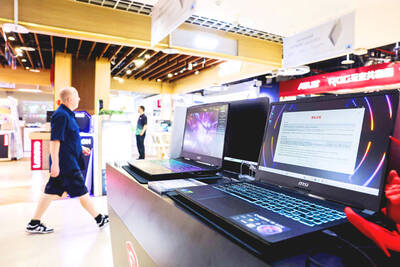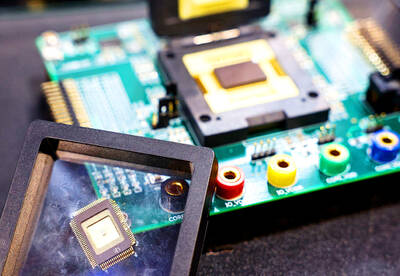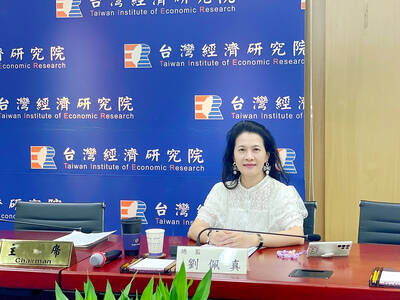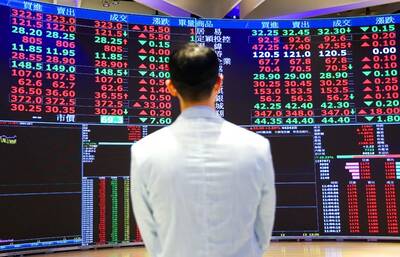In the latest display of its manufacturing might, Intel Corp is opening a US$3 billion factory in the US, widening its lead over smaller rival Advanced Micro Devices Inc (AMD) in the industry's switch to a new chipmaking technique.
The new facility in Arizona will be Intel's first plant dedicated to churning out microprocessors -- the brains of personal computers and servers -- with an average size of 45 nanometers, or 45 billionths of a meter.
The transistors on such chips are so small that more than 30 million can fit onto the head of a pin.
How small they are is critical to the fight between Intel and AMD because smaller features open more room for transistors on a single slice of silicon, boosting performance while lowering manufacturing costs.
The new processors are also made with materials that reduce the amount of electric current escaping from transistors, a major problem as chip parts shrink to the atomic scale.
Intel is at least six months ahead of AMD in the transition to the new chipmaking method.
Intel and AMD currently make their most advanced chips on 65-nanometer technology, and both companies are spending heavily to outfit their factories with the cutting-edge equipment and technologies needed to make 45-nanometer chips.
Intel's new factory, with more than 1,000 workers, is so big that more than 17 football fields could fit inside it.
Its products will go on sale on Nov. 12.
AMD is aiming to roll out chips based on its own new technique -- developed in a partnership with IBM Corp -- in the middle of next year but has not provided more specifics.
Intel is drawing on its deeper financial resources to fund its more rapid changeover.
The company, whose US$150 million market value is 21 times bigger than AMD's, plans to spend up to US$8 billion on upgrading or building factories for 45-nanometer chips.
That figure includes the new factory, up to US$3.5 billion for a new factory in Kiryat Gat, Israel, and US$1.5 billion to retool an existing facility in New Mexico, both of which are scheduled to open next year.
AMD is retooling one of its factories in Dresden, Germany, to handle the new technology. The company has not given a cost for its transition.
The battle over manufacturing technology amplifies the competition between the world's No. 1 and No. 2 makers of microprocessors.
"Customers buy much more than nanometers," AMD spokesman Gary Silcott said. "We may be behind certain companies by a few months in terms of introducing 45-nanometer, but we're way ahead in a number of critical design features. We think we're in a very competitive position."
Intel's lead applies more pressure to AMD as it struggles to emerge from a deep financial funk. AMD has lost US$1.61 billion through the first nine months of the year on sales of US$4.24 billion.
Meanwhile, Intel is thriving, racking up US$4.77 billion in profits on US$27.6 billion in sales over the same period.

IN THE AIR: While most companies said they were committed to North American operations, some added that production and costs would depend on the outcome of a US trade probe Leading local contract electronics makers Wistron Corp (緯創), Quanta Computer Inc (廣達), Inventec Corp (英業達) and Compal Electronics Inc (仁寶) are to maintain their North American expansion plans, despite Washington’s 20 percent tariff on Taiwanese goods. Wistron said it has long maintained a presence in the US, while distributing production across Taiwan, North America, Southeast Asia and Europe. The company is in talks with customers to align capacity with their site preferences, a company official told the Taipei Times by telephone on Friday. The company is still in talks with clients over who would bear the tariff costs, with the outcome pending further

NEGOTIATIONS: Semiconductors play an outsized role in Taiwan’s industrial and economic development and are a major driver of the Taiwan-US trade imbalance With US President Donald Trump threatening to impose tariffs on semiconductors, Taiwan is expected to face a significant challenge, as information and communications technology (ICT) products account for more than 70 percent of its exports to the US, Chung-Hua Institution for Economic Research (CIER, 中華經濟研究院) president Lien Hsien-ming (連賢明) said on Friday. Compared with other countries, semiconductors play a disproportionately large role in Taiwan’s industrial and economic development, Lien said. As the sixth-largest contributor to the US trade deficit, Taiwan recorded a US$73.9 billion trade surplus with the US last year — up from US$47.8 billion in 2023 — driven by strong

A proposed 100 percent tariff on chip imports announced by US President Donald Trump could shift more of Taiwan’s semiconductor production overseas, a Taiwan Institute of Economic Research (TIER) researcher said yesterday. Trump’s tariff policy will accelerate the global semiconductor industry’s pace to establish roots in the US, leading to higher supply chain costs and ultimately raising prices of consumer electronics and creating uncertainty for future market demand, Arisa Liu (劉佩真) at the institute’s Taiwan Industry Economics Database said in a telephone interview. Trump’s move signals his intention to "restore the glory of the US semiconductor industry," Liu noted, saying that

STILL UNCLEAR: Several aspects of the policy still need to be clarified, such as whether the exemptions would expand to related products, PwC Taiwan warned The TAIEX surged yesterday, led by gains in Taiwan Semiconductor Manufacturing Co (TSMC, 台積電), after US President Donald Trump announced a sweeping 100 percent tariff on imported semiconductors — while exempting companies operating or building plants in the US, which includes TSMC. The benchmark index jumped 556.41 points, or 2.37 percent, to close at 24,003.77, breaching the 24,000-point level and hitting its highest close this year, Taiwan Stock Exchange (TWSE) data showed. TSMC rose NT$55, or 4.89 percent, to close at a record NT$1,180, as the company is already investing heavily in a multibillion-dollar plant in Arizona that led investors to assume